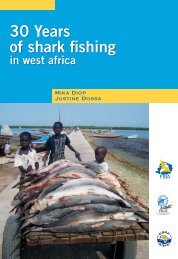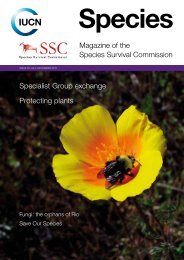Kyne & Simpfendorfer.. - Shark Specialist Group
Kyne & Simpfendorfer.. - Shark Specialist Group
Kyne & Simpfendorfer.. - Shark Specialist Group
Create successful ePaper yourself
Turn your PDF publications into a flip-book with our unique Google optimized e-Paper software.
and in the case of the crocodile shark, two embryos develop in each uterus by feeding on ova<br />
in uterine egg capsules (litter size is thus four) (Fujita 1981, Compagno 2001). Maturity has<br />
been reported at 740mm TL in males and 890mm TL in females, with a maximum size of<br />
1100mm TL (Compagno 2001).<br />
Family Mitsukurinidae. Goblin <strong>Shark</strong>s.<br />
The biology of the rare goblin shark Mitsukurina owstoni remains very poorly-known due to<br />
its infrequent capture and observation (Duffy 1997). Although widely-distributed, a fair<br />
proportion of records for the species come from Japan (Duffy 1997). However, an exceptional<br />
capture of >100 individuals occurred in Taiwan over a two week period in 2003 (Duffy et al.<br />
2004).<br />
The species' mode of reproduction is unknown as gravid females have never been observed<br />
by scientists, but as with other lamnoid sharks, the species is probably oophagous with small<br />
litter sizes (Compagno 2001, Duffy et al. 2004). The goblin shark is one of the largest species<br />
of elasmobranch, Parsons et al. (2002) reporting that it grows to 5400–6170mm TL. Mature<br />
males of 2640, 3200 and 3840mm TL and a mature female of 3350mm TL have been reported<br />
(Compagno 2001).<br />
Family Alopiidae. Thresher <strong>Shark</strong>s.<br />
Like other lamnoids, thresher sharks are oophagous (Gilmore 1993, Musick and Ellis 2005).<br />
The reproductive biology of the bigeye thresher Alopias superciliosus is reasonably well<br />
documented (see review in Gilmore 1993). A litter size of two (one embryo per uteri) has<br />
been confirmed for the species (Gubanov 1979, Gilmore 1983, 1993, Moreno and Morón<br />
1992, Chen et al. 1997), although litter sizes of 3 or 4 also occur less regularly (Compagno<br />
2001).<br />
Chen et al. (1997) found gravid females throughout the year off Taiwan in the Northwest<br />
Pacific, with no defined mating or pupping season. Similarly, Moreno and Morón (1992)<br />
could not find evidence of a well defined breeding season in the Eastern Central Atlantic,<br />
although they suggested a possible preferential pupping season in autumn-winter. Without<br />
defined reproductive seasonality it is difficult to determine gestation period, although it has<br />
been estimated as 12 months in the bigeye thresher (Holden 1974). Diel vertical migration<br />
patterns in A. superciliosus (Nakano et al. 2003, Weng and Block 2004) are discussed later in<br />
this Section (see page 104).<br />
Estimates of maturity and size at birth vary regionally and these are summarized in Gilmore<br />
(1993) and Chen et al. (1997). Size at maturity equates to 76–79%TL max in females and to 67–<br />
79 TL max in males, and size at birth ranges from 600–1400mm TL (Chen et al. 1997). Verified<br />
age estimates for A. superciliosus from Taiwan gives longevities of 20 years and 19 years for<br />
females and males, respectively (Liu et al. 1998) (Table 2.10).<br />
Table 2.10. Age and growth parameters for Alopias superciliosus from Taiwan, Northwest<br />
Pacific (Liu et al. 1998). von Bertalanffy growth model (VBGM) parameters: L ∞ (mm TL), k<br />
(year -1 ), t 0 (years); t max oldest fish (years), A mat age at maturity (years).<br />
VBGM parameters<br />
Sex L ∞ k t 0 t max A max<br />
♀ 2246 0.092 -4.21 20 12.3-13.4<br />
♂ 2188 0.088 -4.24 19 9-10<br />
82
















